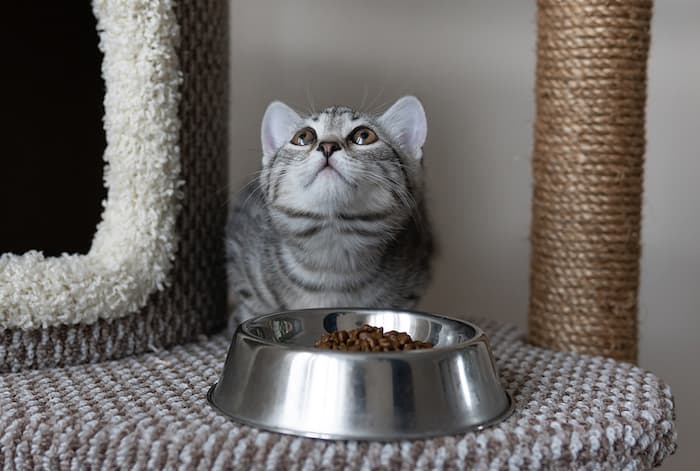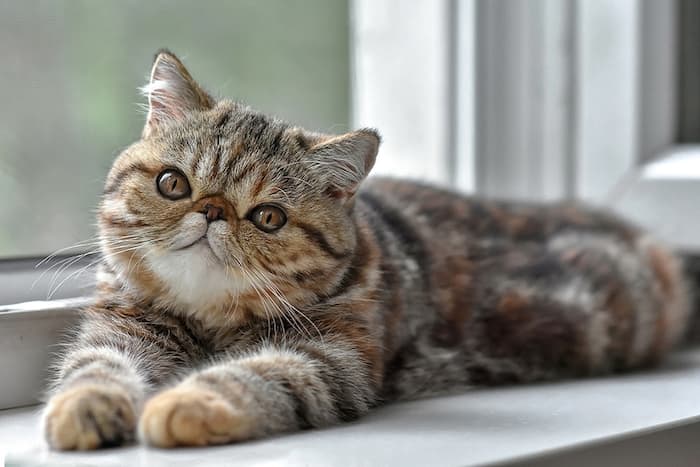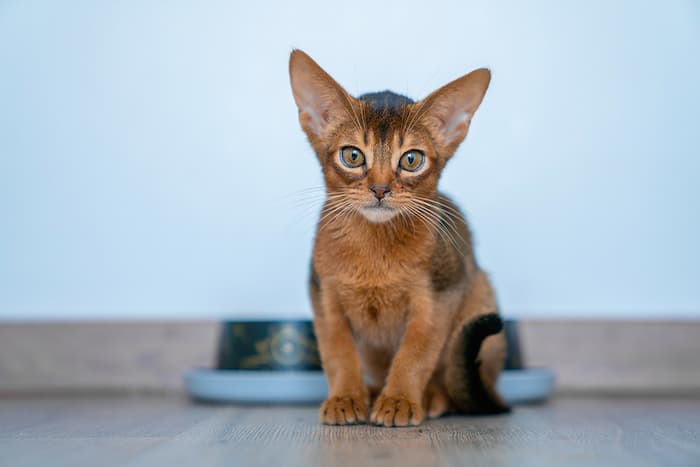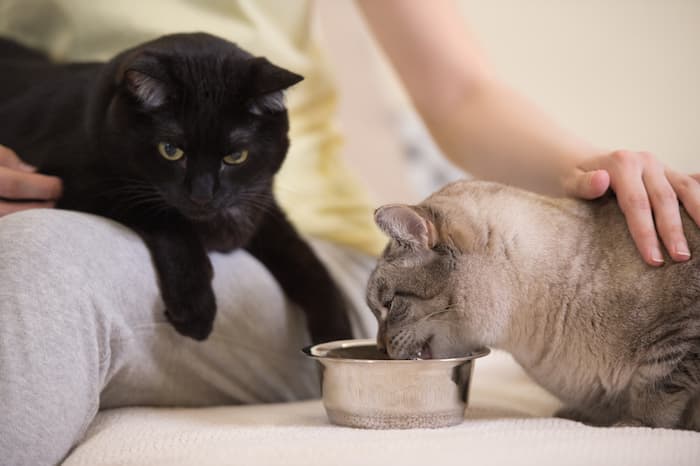Proper nutrition is the cornerstone of a kitten’s health, setting the stage for a robust and healthy life. During their early months, kittens undergo rapid growth and development, making their nutritional needs distinctively different and more demanding than those of adult cats.

Importance of Nutrition in Early Stages
The first few months of a kitten’s life are critical for setting up a strong foundation for lifelong health. Proper nutrition during this period supports the development of vital organs, boosts the immune system, and is essential for the growth of strong bones and muscles. It also plays a significant role in the development of a healthy fur coat and aids in cognitive development.
Key Nutrients for Kitten Growth
- High-Quality Animal Proteins: Proteins are the building blocks of growth. They are crucial for the development of muscles, tissues, and organs. Look for kitten foods where the primary source of protein is an animal-based ingredient like chicken, fish, or lamb.
- Fats and Fatty Acids: Essential fatty acids, particularly Omega-3 and Omega-6, are vital for brain development, heart health, and a shiny coat. Fats also provide energy, which is vital for playful, energetic kittens.
- Vitamins and Minerals: Vitamins A, D, E, and K are essential for vision, bone growth, and immune health. Minerals like calcium and phosphorus are critical for strong teeth and bones. Taurine, an amino acid, is crucial for heart and eye health.
- Carbohydrates and Fibers: While not as critical as proteins and fats, good quality carbohydrates and fibers from sources like rice and vegetables can provide energy and aid in digestion.
Proper kitten nutrition isn’t just about feeding them enough; it’s about feeding them right. Quality food, balanced for a kitten’s specific growth needs, can set the stage for a lifetime of good health. Remember, when in doubt, consult a veterinarian, especially if your kitten has specific health issues or dietary needs.

Choosing the Right Kitten Food
Selecting the right food for your kitten is a pivotal decision that impacts their overall health and development. With various options available, it’s essential to understand what sets them apart and what to look for to ensure your kitten’s nutritional needs are met.
Types of Kitten Food
- Wet Food: This type is often more palatable for kittens and helps with hydration. It’s usually richer in protein and fat, which are essential for growth. However, it can spoil faster once opened and might be more expensive in the long run.
- Dry Food: Convenient and cost-effective, dry food is good for free-feeding as it doesn’t spoil as quickly. It also helps in maintaining dental health by reducing tartar buildup. However, it’s crucial to ensure your kitten stays hydrated as dry food has low moisture content.
- Raw Diets: These aim to mimic a cat’s natural diet. Raw diets can provide fresh, unprocessed foods, but they require strict hygiene practices to prevent bacterial contamination. It’s vital to consult a veterinarian before choosing a raw diet to ensure it’s balanced and safe.
Reading Food Labels
- Primary Ingredient: High-quality kitten food should list a source of animal protein (like chicken, fish, or beef) as the first ingredient. This ensures the food is protein-rich.
- By-Products and Fillers: Be wary of foods with excessive by-products and fillers like corn and wheat. These are often used to bulk up the food but offer little nutritional value.
- Additives and Preservatives: Avoid foods with artificial colors, flavors, or preservatives. Natural preservatives are preferable for kitten health.
- Nutritional Adequacy Statement: Look for a statement from the Association of American Feed Control Officials (AAFCO) that confirms the food is complete and balanced for kittens.
When choosing the right food, consider your kitten’s individual preferences and needs. Some kittens may have specific dietary requirements or sensitivities that necessitate a particular type of food. It’s also worth noting that dietary needs change as kittens grow. Regularly evaluate your kitten’s diet to ensure it continues to meet their nutritional needs as they transition from kittenhood to adulthood.

Feeding Your Kitten: The First Six Months
The first six months of a kitten’s life are a period of rapid growth and development. During this time, it’s crucial to provide them with a diet that meets their high energy and nutritional needs. Here’s how to ensure your kitten is getting the right amount and type of food for optimal health.
Frequency and Quantity of Feeding
- Newborn to 4 Weeks: Kittens under four weeks old typically rely on their mother’s milk. If you’re hand-rearing a kitten or supplementing, use a high-quality kitten milk replacer, not cow’s milk. Feed them every 2-4 hours, including overnight.
- 4 to 8 Weeks: Start introducing wet kitten food, ideally mixed with kitten milk replacer, to create a gruel. Gradually reduce the milk replacer. Feed small amounts 4-6 times a day.
- 2 to 6 Months: As your kitten grows, gradually transition to more solid food. At this stage, they should be eating primarily high-quality wet and dry kitten food. Feed 3-4 times a day.
Balancing a Growing Kitten’s Diet
- Nutritional Balance: Ensure the food you provide is specifically formulated for kittens. Kitten food is higher in calories, protein, and fat, which are essential for their growth and development.
- Monitor Growth and Health: Regularly check your kitten’s weight and overall health. Adjust the diet if necessary, and consult a veterinarian if you have concerns about their growth or health.
- Hydration: Always have fresh water available. Wet food contributes to hydration, but additional water is still necessary, especially if your kitten eats mostly dry food.
Avoiding Common Feeding Mistakes
- Overfeeding: While kittens need more calories than adult cats, overfeeding can lead to obesity. Follow feeding guidelines and adjust as needed based on your kitten’s activity level and growth.
- Underfeeding: Conversely, underfeeding can hinder development. Ensure your kitten is getting enough food at each meal.
- Inappropriate Foods: Avoid feeding human foods that can be toxic to cats, like onions, garlic, chocolate, and grapes.
Remember, every kitten is unique, and their feeding needs can vary based on factors like breed, size, and activity level. Regular veterinary checkups can help keep track of your kitten’s health and ensure their dietary needs are being met effectively.
For more insights on kitten nutrition and feeding practices, professionals like Darina from Meowoff can be invaluable resources, offering tailored advice to ensure the health and well-being of your growing Maine Coon kittens.
Special Dietary Considerations
Addressing specific dietary needs and knowing when to consult a vet is vital for your kitten’s health.
- Common Kitten Dietary Issues: Be aware of potential issues like allergies or sensitivities and choose diets that mitigate these risks.
- When to Consult a Veterinarian: If your kitten shows signs of poor growth, digestive issues, or other health concerns, consult a veterinarian immediately.

Transitioning to Adult Cat Food
Transitioning from kitten to adult cat food is a significant step in your cat’s life. This process should be gradual and carefully managed to ensure your cat maintains good health and adapts well to the change in diet.
Signs Your Kitten Is Ready for Adult Food
- Age: Most kittens are ready to transition to adult cat food at about 12 months. However, some larger breeds like Maine Coons may require a longer kittenhood feeding period.
- Physical Maturity: Look for signs of physical maturity, such as a decrease in rapid growth rate, reaching near adult size, and sexual maturity.
- Activity Level: You might notice a decrease in hyperactive play, indicating a reduction in energy requirements.
How to Transition Safely and Effectively
- Gradual Introduction: Start by mixing a small amount of adult food with the kitten food. Over the next 7-10 days, gradually increase the proportion of adult food while decreasing the kitten food.
- Monitor the Reaction: Pay attention to how your cat reacts to the new diet. Look for signs of digestive upset, like vomiting or diarrhea, and adjust the transition speed accordingly.
- Quality of Adult Food: Choose high-quality adult cat food that meets your cat’s nutritional needs. This should be based on factors like size, breed, and activity level.
- Consult a Veterinarian: If you’re unsure about when to switch or what food to choose, consult your veterinarian. They can provide guidance tailored to your cat’s specific needs.
Common Challenges and Solutions
- Picky Eaters: Some cats may be reluctant to change foods. In such cases, try different flavors or brands of adult food to find one they like.
- Overfeeding: Adult cat food is less calorie-dense than kitten food. Be mindful of portion sizes to avoid overfeeding and weight gain.
- Maintaining Interest: To keep your cat interested in their food, consider rotating between dry and wet food or trying different flavors.
Transitioning to adult cat food is a process that requires patience and observation. It’s important to ensure that your cat is receiving the right balance of nutrients for their life stage.

Maintaining a Healthy Diet into Adulthood
As your kitten transitions into adulthood, maintaining a balanced and nutritious diet becomes crucial for their long-term health and well-being. Adult cats have different nutritional needs compared to kittens, and these needs can change over time based on age, health, and lifestyle.
Long-term Dietary Requirements
- Protein: Adult cats still require high-quality protein, but not as much as kittens. Ensure the diet includes easily digestible proteins to support muscle maintenance and overall health.
- Fats and Carbohydrates: A balanced amount of fats is essential for energy and healthy skin and fur. Carbohydrates should be present in moderation to provide energy without leading to weight gain.
- Vitamins and Minerals: Continue providing a diet rich in essential vitamins and minerals. Pay special attention to taurine, an amino acid crucial for heart and eye health.
- Fiber: Adequate fiber is important for digestive health. It helps prevent issues like constipation and aids in weight management.
Adjusting Diet with Age and Activity Level
- Activity Level: More active cats may require more calories and nutrients. Conversely, less active or indoor cats may need fewer calories to avoid weight gain.
- Age-Related Changes: As cats age, they may become prone to issues like dental problems, obesity, or kidney disease. Adjust their diet to address these concerns, such as softer food for dental issues or low-phosphorus food for kidney health.
- Regular Health Check-Ups: Regular veterinary check-ups can help identify any dietary needs based on health changes. Your vet can recommend specific dietary adjustments or special diets.
Monitoring and Adjusting Feeding Practices
- Portion Control: Monitor your cat’s food intake to prevent overeating. Use feeding guidelines on food packages as a starting point and adjust based on your cat’s specific needs.
- Feeding Routines: Establish a consistent feeding routine. Some cats do well with free-feeding, while others may need portioned meals to manage weight.
- Hydration: Ensure your cat has constant access to fresh water, especially if they primarily eat dry food.
Dealing with Dietary Challenges
- Food Allergies or Sensitivities: Be aware of signs of food allergies or sensitivities, such as skin irritation or gastrointestinal issues. Consult with a veterinarian for diet modifications.
- Changing Preferences: Cats’ food preferences can change over time. Be open to trying different foods to accommodate their tastes.
Maintaining a healthy diet for your adult cat is about finding the right balance and being responsive to their changing needs.
Additional Resources and Product Recommendations
For further information and product suggestions, consider the following.
- Recommended Brands and Products: Choose reputable brands that prioritize high-quality ingredients. Look for those recommended by veterinarians and cat nutrition experts.
- Further Reading and Professional Advice: Stay informed about the latest in feline nutrition and consult your veterinarian for personalized advice.
